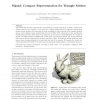Free Online Productivity Tools
i2Speak
i2Symbol
i2OCR
iTex2Img
iWeb2Print
iWeb2Shot
i2Type
iPdf2Split
iPdf2Merge
i2Bopomofo
i2Arabic
i2Style
i2Image
i2PDF
iLatex2Rtf
Sci2ools
CGF
2011
2011
SQuad: Compact Representation for Triangle Meshes
The SQuad data structure represents the connectivity of a triangle mesh by its “S table” of about 2 rpt (integer references per triangle). Yet it allows for a simple implementation of expected constant-time, random-access operators for traversing the mesh, including in-order traversal of the triangles incident upon a vertex. SQuad is more compact than the Corner Table (CT), which stores 6 rpt, and than the recently proposed SOT, which stores 3 rpt. However, in-core access is generally faster in CT than in SQuad, and SQuad requires rebuilding the S table if the connectivity is altered. The storage reduction and memory coherence opportunities it offers may help to reduce the frequency of page faults and cache misses when accessing elements of a mesh that does not fit in memory. We provide the details of a simple algorithm that builds the S table and of an optimized implementation of the SQuad operators. Categories and Subject Descriptors (according to ACM CCS): I.3.3 [Computer Gra...
| Added | 25 Aug 2011 |
| Updated | 25 Aug 2011 |
| Type | Journal |
| Year | 2011 |
| Where | CGF |
| Authors | Topraj Gurung, Daniel E. Laney, Peter Lindstrom, Jarek Rossignac |
Comments (0)

